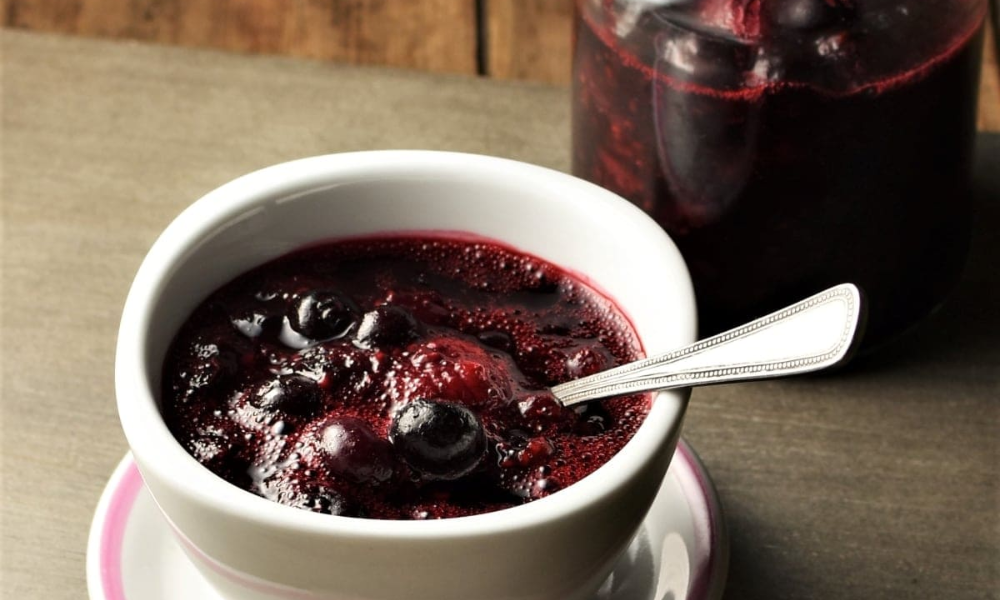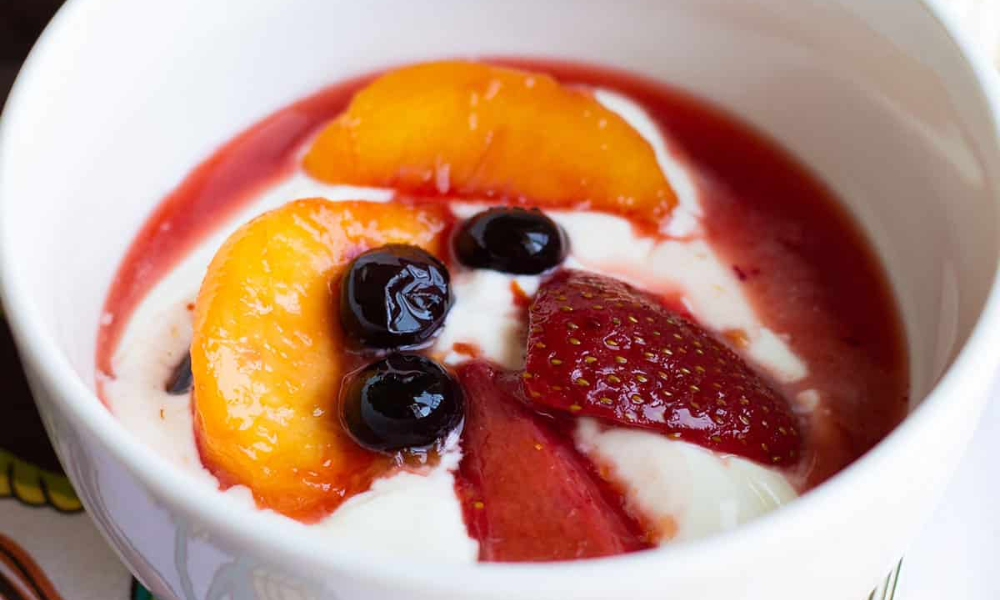This simple 2-ingredient fruit compote is a great way to enjoy summer fruit. It may be made very easily and fast, and there are many different ways to serve it. Fruit that has been cooked with sugar (such as honey or granulated sugar) to produce a syrupy fruit mixture is known as a fruit compote.
Given how quickly it cooks, the fruit is still able to preserve its shape while releasing a considerable amount of liquid. Compotes of fruit have been enjoyed for a very long time. It’s easy to make using easily accessible components, cheap, and a terrific way to use up the bounty of the summer.
What is a Fruit Compote?
Whether it is consumed by itself or in combination with other desserts, a vibrant fruit compote makes a great conclusion to a casual or holiday meal. Fresh, tinned, or dried fruit that has been simmered in a syrup of sugar and other flavorings is referred to as compote in the culinary arts. In a compote, the fruit is chopped into pieces.
Dried fruit is frequently soaked in water to make it softer before being added to a compote. Recipes for compote may call for wine, brandy, rum, or liqueur. Common fruit compote ingredients include figs, pears, apples, plums, berries, and rhubarb. Recipes for compote typically call for additional flavorings like vanilla, cinnamon, citrus peels, and cloves.
How to Make Fruit Compote?
There are many fruit compote recipes available, and while it is wise to stick to a specific recipe, a basic fruit compote typically calls for a combination of fresh, tinned, or softened dried fruits. To start things off, you place the fruit in a pot or saucepan and add some liquid, such as juice, wine, or syrup. Keep in mind that the fruit will leak some of its natural moisture as it cooks if you add too much liquid.
Add sugar to the pot if any of the fruit has a sour flavor. Use vanilla, ginger, or cinnamon to your preference to enhance the flavor. Avoid crushing the fruit by simmering it in the pot while stirring it occasionally. Your compote will be thick and prepared to be removed from the heat in around 15 minutes.
Ingredients:
- 16 ounces of fresh or frozen fruit weighing 1 pound (for the photos, I used fresh strawberries, peaches, and frozen blueberries)
- 2 teaspoons of maple syrup or honey
- little salt
- See the recipe’s optional seasoning suggestions above.
Instructions:
- If you’re using fresh peaches or strawberries, slice them into tiny rounds before serving. Blueberries and raspberries are small berries that can be used whole. There is no need to defrost or slice frozen fruit before usage.
- Your preferred fruit, a splash of salt, and your preferred sweetener should all be combined in a medium saucepan. Over medium-high heat, bring the mixture to a boil while occasionally stirring. For fresh fruit, this will take approximately 5 minutes; for frozen fruit, it will take around 10 minutes.
- Reduce the heat to medium once it has boiled. Use a potato masher or serving fork to mash the fruit until it has the right consistency if you’re using chunky fruit or want it to be smoother. It will take around 5 minutes of simmering and frequent stirring for the compote to reduce to about half of its initial volume.
- The compote should be taken off the heat. The compote is normally sweet enough for me at this stage, but you can add additional sweetener to taste if you think it needs it. Mash it up a bit more if you want it to be smoother.
- Before serving, let the compote cool for a few minutes. Before covering and storing leftover compote in the refrigerator for up to 10 days, let it cool completely.
How to Serve Fruit Compote?
Compotes taste great when served as a dessert on their own after a meal. Typically served warm, though occasionally cooled. They may also be the main component of other recipes. The following are some ideas for adding fruit compote to your menu:
- Put raspberry compote on top of ice cream or pound cake.
- For an opulent dessert course, serve a compote made with apricots, raisins, dried cherries, apples, pears, and Marsala wine with a variety of cheeses.
- Over the black currant syrup, spoon a red compote of cherries, red grapes, and strawberries. Garnish with sweetened whipped cream.
- Compote and custard or yogurt are layered.
- Pour a few teaspoons of pureed compote and sparkling wine into a large glass.
- Strawberry compote should be served with whipped cream and a shortcake.
- Serve pancakes with peach compote for breakfast.
- Use mixed-berry compote to top the baked French toast.
Compote vs. Jam: What’s the Difference?
With a few caveats, you can replace compote for jam because the two are comparatively comparable. Jam and compote differ primarily in two ways: Compote is less spreadable than other desserts. Most jams are spreadable due to their consistency, which is generally consistent.
Compote, which could include intact fruit bits, can be a little more challenging to spread uniformly. Storage: Compote is not intended to be kept in the refrigerator; jam is. Compared to a regular jar of jam, most compotes are lower in sugar. The calories are slightly reduced as a result, but the preserving effects of sugar are lost.
As a result, jam can survive for up to a month after being opened, whereas compote normally keeps for approximately two weeks in the refrigerator. Jam, marmalade, and fruit butter are not the same as compote. Apple butter is a good option if you want a product with no added sugar. Consider grapefruit or orange marmalade, where citrus rinds are a prominent component if you enjoy the flavor of citrus peels. Consider jelly, which is mostly made of fruit juice, sugar, and pectin, if you desire a spread with potent gelling abilities.
How Long does Compote Last?
Compotes, which are sweeter than chutneys but are rarely kept for a long time in a jar or can, are distinct from other fruit preserves like jams, jellies, and even marmalades since they don’t rely on lemon or citrus juice combined with citrus rinds.
A compote is typically made to go with a certain item, like a dessert or piece of meat. Compotes should be consumed right away after preparation. Since there is no requirement for the preservation properties of sugar in this quick procedure, cooks can use less sweetener than they do in fruit jam recipes.
It should only be kept for as long as its most flimsy component, which would be the weak sugar syrup, thus it should keep in the fridge for a few days to a week. Now, generally speaking, compotes are much sweeter and more acidic than the recipe you’ve linked to. Pour the warm compote into the jars with care and seal them immediately. Your jars will look nice enough to be given as gifts if you use some attractive jam lids and covers.
For up to two weeks, keep it in the refrigerator. Freeze compotes in batches in plastic containers to preserve them longer and ensure that you only thaw what you actually need.
How to Thicken Fruit Compote?
Simply combine 1 tablespoon of cornstarch with 1.5 tablespoons of cold water and stir it into your fruit compote while it cooks to thicken it and make it into a fruit pie filling. Alternately, after the mixture has been cooked, thicken it. Bring to a boil and simmer, stirring often, for 2 minutes or until the mixture has thickened. Perhaps more sugar should be added to this mixture.
Including dried fruit in the mixture is an additional method for making a thick fruit sauce. In my blackberry coffee cake recipe, which called for a layer of fruit, I employed this technique. I boiled fresh blackberries, dried prunes, and a little sugar to make a thick, jam-like combination that would be ideal for a cake.
What do you Eat with Fruit Compote?
Strawberry compote should be served with whipped cream and a shortcake. Serve pancakes with peach compote for breakfast. Use mixed-berry compote to top the baked French toast. Shortcakes and whipped cream should be served with strawberry compote. Breakfast should consist of pancakes with peach compote. For the baked French toast’s topping, use mixed-berry compote. Place all the fruits in a large pan and add 2-3 tablespoons of water, sugar to taste, and any additional flavorings you choose.
After bringing it to a boil, simmer for 3–5 minutes. Avoid overcooking to prevent the fruits from losing their form. keeps for up to two days in the refrigerator and three months in the freezer. A dish for serving compote (fruits cooked in syrup), typically with a stem and base and occasionally with a cover, or a smaller dish of a similar shape used for individual servings.
Conclusion
Compote, a type of fruit spread, is made by combining sugar syrup with fruit chunks or whole fruits. It is carefully cooked because of its unique flavor. Bakers can add herbs, spices, or a splash of alcohol to compotes to give them flavor. Some recipes also call for thickeners such as powdered pectin to give the mixture more substance. Compote may be spreadable like jam or it may have more fruit pulp, akin to a fruit purée, depending on the recipe.
The density and number of solids in a compote are determined by the amount of pectin used in a particular recipe and the size of the fruit pieces; a compote with less pectin will be smoother. Almost always, they come with a variety of sizable pieces of fruit. A fruit puree mixture is more appropriately known as a coulis. The compote tastes best when eaten immediately, though it can be chilled for a brief period of time.

